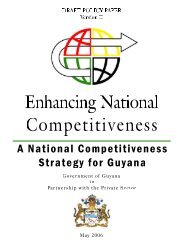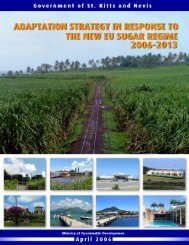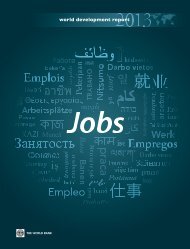Business Removing
Doing Business in 2005 -- Removing Obstacles to Growth
Doing Business in 2005 -- Removing Obstacles to Growth
- No tags were found...
You also want an ePaper? Increase the reach of your titles
YUMPU automatically turns print PDFs into web optimized ePapers that Google loves.
66 DOING BUSINESS IN 2005<br />
enforcement are associated with a smaller size of businesses<br />
in Mexico. There, 96% of businesses employ less<br />
than 10 workers. In the United States, only about 63%<br />
of businesses do. And the efficiency of debt collection<br />
varies across Mexican states, with the top one, Aguascalientes,<br />
being nearly three times as efficient as the bottom<br />
one, Guerrero. Improvements in debt recovery from<br />
the bottom to the top quartile of states imply a large<br />
jump in employment—a 17% increase in the number of<br />
workers in the average business. 26<br />
Reforms of debt collection reduce costs to the government<br />
as well. This was the original motivation behind the<br />
Woolf Report in the United Kingdom. The simpler the<br />
procedures, the less the need for more court clerks and<br />
judges. The more summary judgments, the less the taxpayer<br />
money used to fund drawn out trials. The government can<br />
instead direct more resources to legal aid for the poor.<br />
FIGURE 8.8<br />
More procedures—more corruption…<br />
Perception of judicial integrity<br />
…less efficiency<br />
Perception of judicial efficiency<br />
Positive<br />
Positive<br />
Negative<br />
Negative<br />
Least<br />
Most Least Most<br />
Countries ranked by procedures to enforce a contract, quintiles<br />
Countries ranked by procedures to enforce a contract, quintiles<br />
Note: The relationships shown are significant at the 1% level and remain significant at the 5% level when controlling for income per capita.<br />
Source: Doing <strong>Business</strong> database, WEF (2004).<br />
Notes<br />
1. An interview reported in Kahn (2003), p. 27.<br />
2. World Bank (2004c).<br />
3. Based on analysis of the Doing <strong>Business</strong> indicators with indicators of<br />
impartiality of the judiciary from Economic Freedom of the World and<br />
Batra and others (2003). Results are significant at the 5% level, controlling<br />
for income per capita.<br />
4. Samano (2002), p. 9.<br />
5. A recent report on case management in the Canadian judiciary suggests<br />
as a main indicator of success the ratio of cases judged in summary proceedings<br />
to cases judged in regular proceedings. The rationale is that<br />
summary proceedings reflect the willingness of judges to provide quick<br />
resolution. See Quebec Ministere de la Justice (2001).<br />
6. Laukkanen (2004).<br />
7. Surveys published in Pravda newspaper, various issues.<br />
8. Zuckerman (1999).<br />
9. Deloitte Consulting (2003).<br />
10. Hendley (2004).<br />
11. Proskuryakova (2002).<br />
12. World Bank (2003b).<br />
13. Creditors complained of a pro-debtor bias in judgments. The evidence<br />
suggests otherwise. Nearly 90% of judgments in Mexico and 80% of<br />
judgments in Argentina were in favor of the creditor. These percentages<br />
rose after appeal.<br />
14. Lord Woolf (1995).<br />
15. See Australian Law Reform Commission (2003) for a summary of<br />
reforms.<br />
16. On average, the cost of dispute resolution is 15% with case management,<br />
and 25% without. This difference exists at all income levels.<br />
17. Korb (2002).<br />
18. World Bank (2003c).<br />
19. CEELI (2004).<br />
20. World Bank (2003d).<br />
21. Kennett (2002).<br />
22. Data on remuneration of enforcement agents was collected for the first<br />
time in this year’s survey. The questionnaire is available at the Doing<br />
<strong>Business</strong> website.<br />
23. Hendley (forthcoming).<br />
24. See, for example, Buscaglia and Dakolias (1999).<br />
25. Djankov and others (2004).<br />
26. Laeven and Woodruff (2004).

















